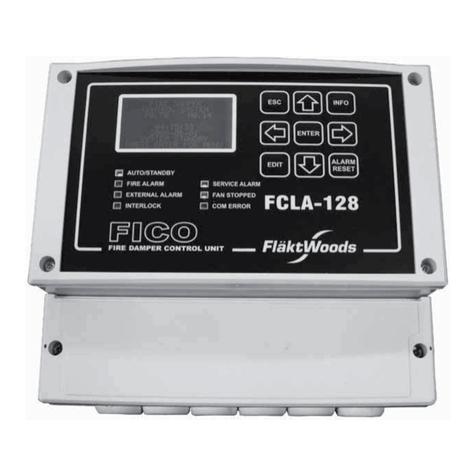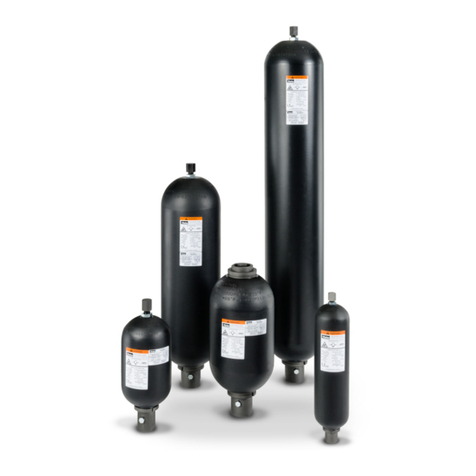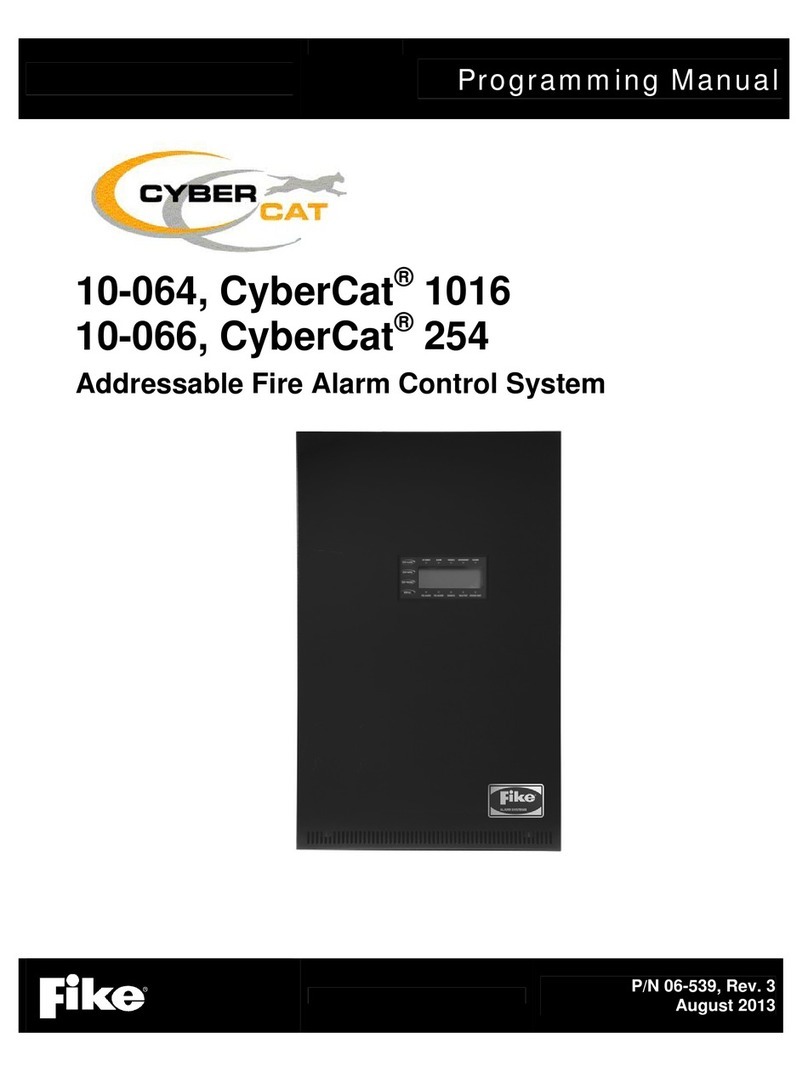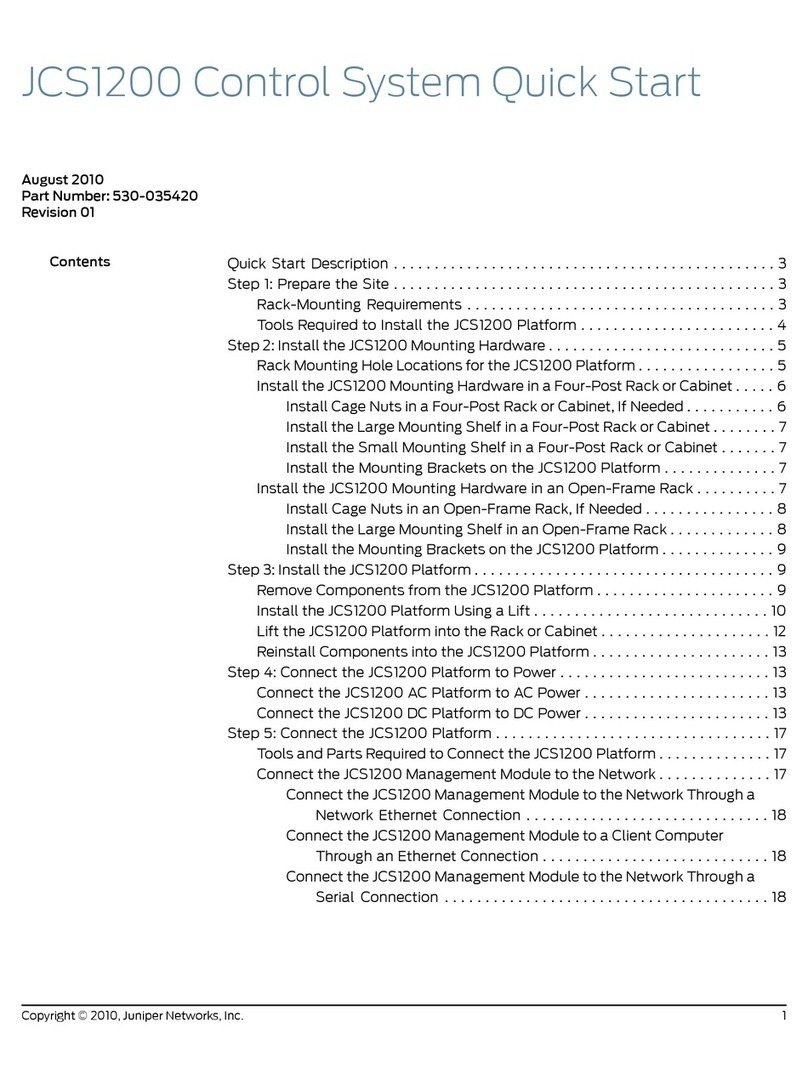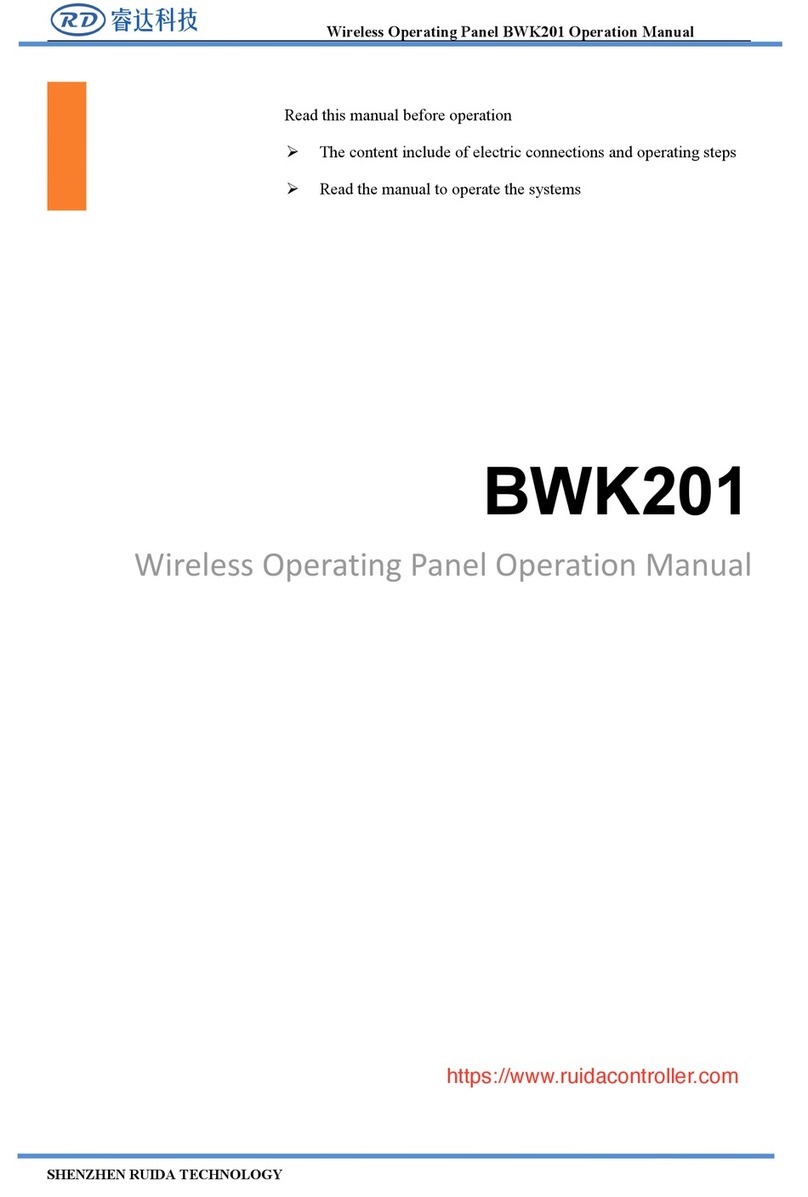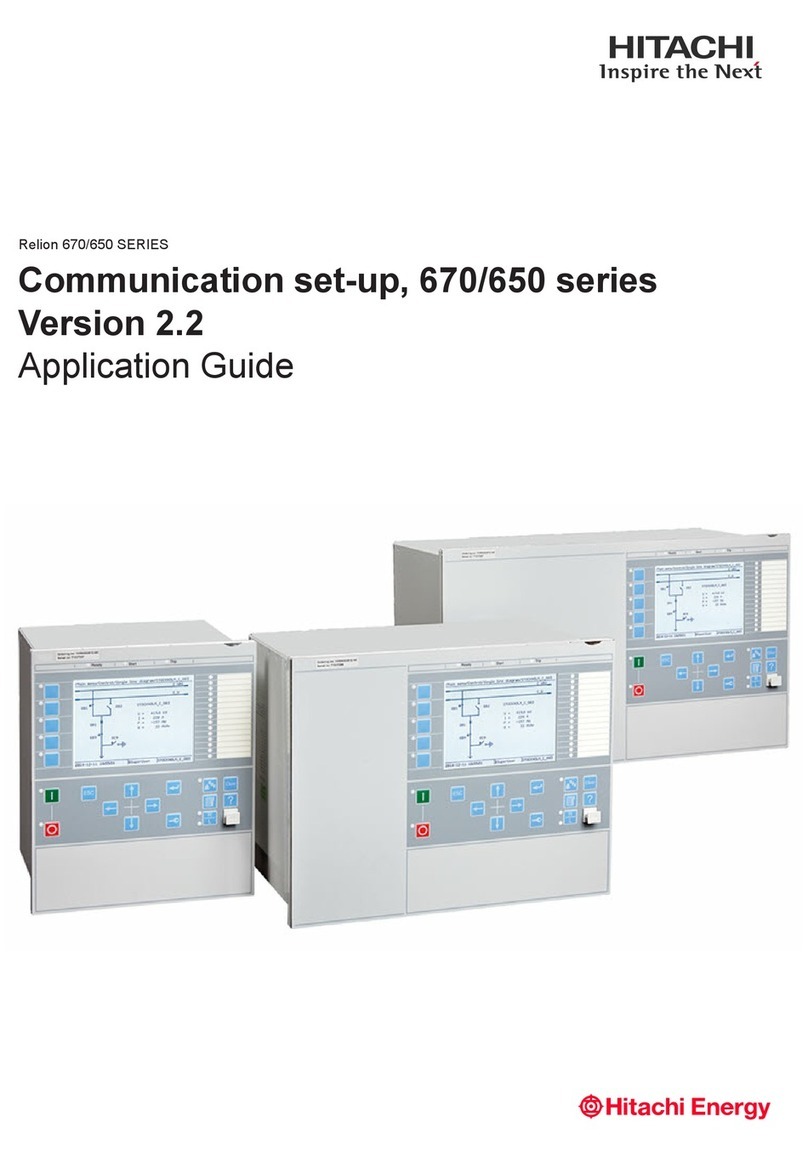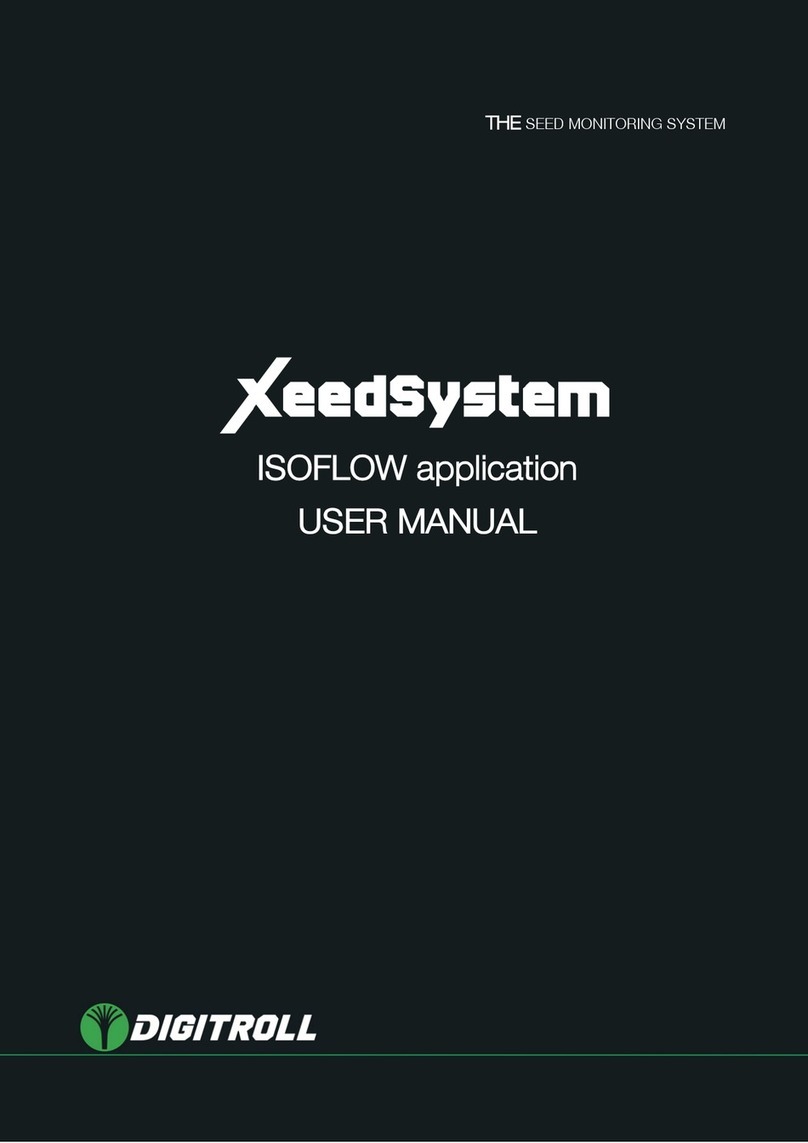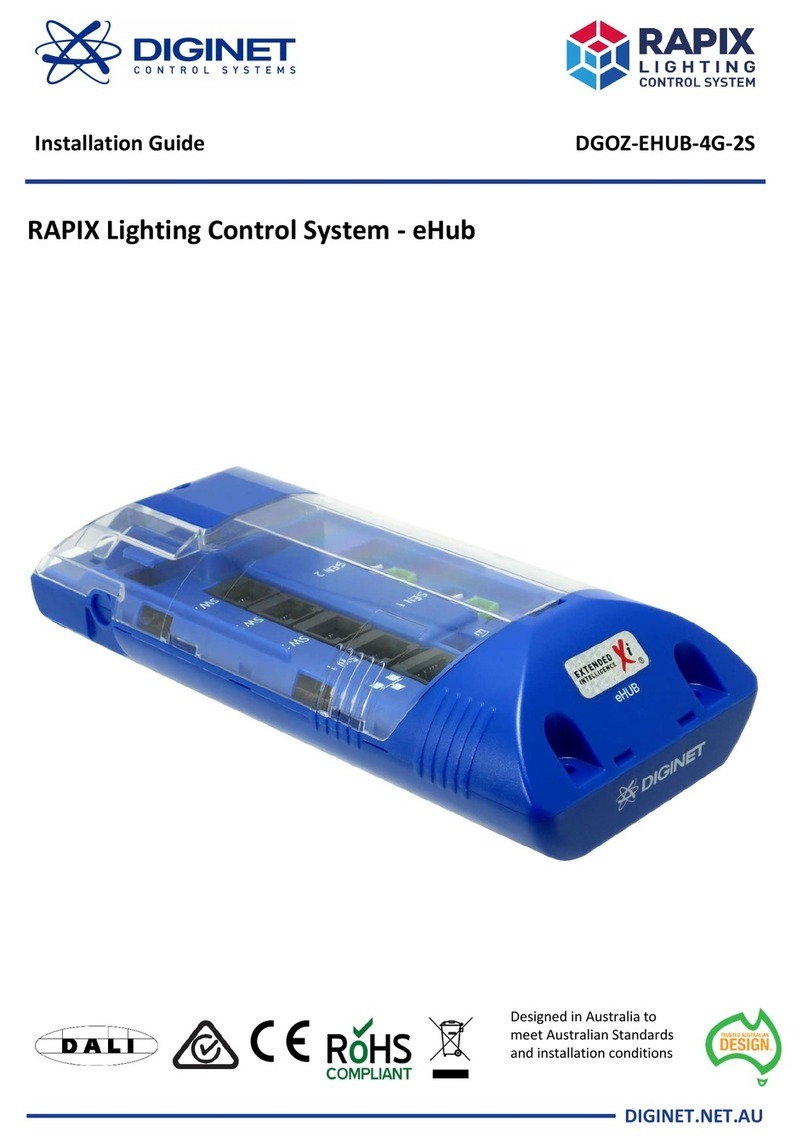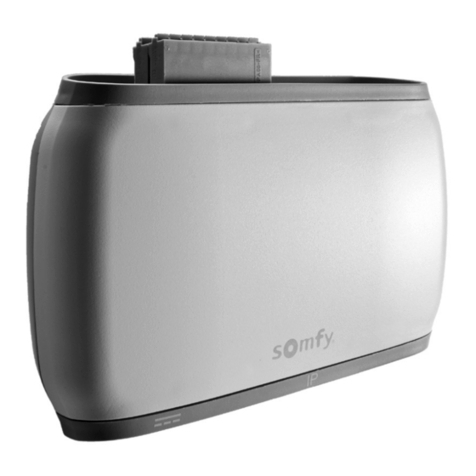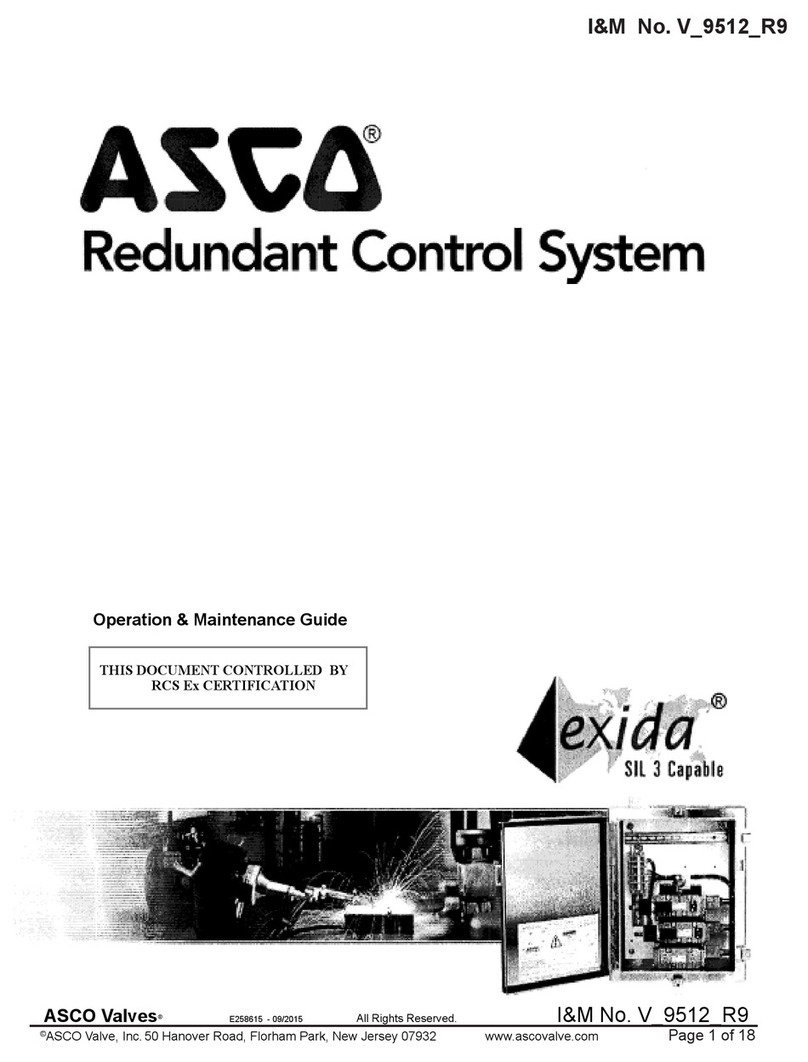flakt woods eq Controls Instruction Manual

eQ Controls
Assembly and installation
AIRTREND Ltd
Predstavništvo u Beogradu
Kumanovska 14, 11000 Beograd
Tel: 011/3836886, 3085740
Faks: 011/3444113
e-mail: [email protected]
web: www.airtrend.rs

1. Identify components supplied separately against the enclosed bill of materials.
2. Fit external cable trunking (accessories), see page 14.
3. Connect the power and signal wiring to adjacent blocks, see page 15.
4. Connect sensors, actuators and accessories; see pages 12 and 17–31.
5. Connect the incoming supply, see pages 4–11.
6. Switch on the power. The control system starts.
7. Configure the control system using the display, see page 42–47.
a) Log in. Password: 2000
b) Current time
c) Fan setpoints
d) Temperature setpoints
e) Desired operating period
8. The air handling unit is ready for use.
Limits of responsibilities
Although Fläkt Woods has tested and reviewed the
documentation contained in this manual, Fläkt Woods
makes no warranty, neither expressed nor implied, with
respect to this manual, including its quality, performan-
ce, or tness for a particular purpose.
Fläkt Woods shall under no circumstances be liable
for direct, indirect, special, incidental or consequential
damage arising from the use or the inability to use
information contained in this manual. Fläkt Woods
reserves the right to revise this publication at any time
and to make changes to its content without prior notice
and has no duty to provide notice to previous or current
owners with respect such revisions or changes.
NOTE! Prior to physical connection, air handling unit accessories not supplied with the unit, such as actuators, coolers and
active sensors etc., must first be configured in the controller. Contact Fläkt Woods support for advice.
Procedure

Fläkt Woods 8666 GB 2010.06 Specifications are subject to alteration without notice
Installation and maintenance instructions
Control equipment
3
Procedure 2
Control panel, sizes 0.55–5.5 kW 4
Control panel, size 7.5 and 11–15 kW 5
Electrical connection for Norway 6
Connecting the service power supply for lighting 7
Connecting the energy analyser 10
Cable dimensions and currents, 0.55–15 kW 10
Power consumption eQ 11
Connecting sensors and accessories 12
Lighting control in the control panel 13
Connection power supply lighting 13
Fitting cable truning 14
Electrical connection of units in blocks 15
Connection board 16
Temperature sensor 17
Pressure/flow sensor 18
Configuration of the sensor 19
Zero calibration 19
k-factors 19
Temperature correction 19
CO2 sensor 20
Damper actuators 21
Filter monitors 23
Fan monitors 23
Timer, push button, motion detector and
CO2monitor 24
External Timer 24
Push button 24
CO2monitor 25
Motion detector 26
Heating coil 27
Cooling coil 27
Heat exchanger 28
Permissible mounting methods 29
Frost protection sensor 29
Electric heating 30
Output and current for electric heaters 32
Minimum flows for duct-mounted electric heater 33
Minimum flows for air handling unit-mounted
electric heater EQEK 33
DX cooling 34
Z sensor 34
ECONET®35
Preheater 36
Temperature zones and external fans 37
Fire protection unit and/or external stop 38
Operation of fans in the event of fire 39
Connecting external components in
the control panel 40
Connecting components in the junction box 41
Using the controller 42
Updating SD cards 43
Menu navigation 43
Overview of the menu structure 46
Activating control functions 47
Questions and answers 48
Alarm guide 50
Contents

4Fläkt Woods 8666 GB 2010.06 Specifications are subject to alteration without notice
Installation and maintenance instructions
Control equipment
Control panel, sizes 0.55-5.5 kW
1. Connecting the lighting switch
2. Display connector, (HMI*), Ethernet, USB
3. Circuit board with terminal blocks for accessories
4. Space for a communication module
5. SD card reader
6. Modem
7. Earthing bar
8. Transformer
9. Junction box connections
10. Glass fuses, power supply 24 VAC and 24 VDC
11. A and B alarm outputs/Run Ind
12. Start/Operation Heating/Cooling
13. Incoming supply for service lighting
14. Incoming supply, 0.55 kW–5.5 kW
15. Power supply, air handling unit loads, 3-phase.
16. Control panel electrical supply
17. Internal operation
* It is also possible to connect the display via KNX
(for example for outdoor units where longer cable is
needed).
Please note that the response time decreases when
using this connection.
Connect the incoming supply to terminal block 14 (see
the gure above) in the control panel. Connect the
protective earth directly to the earthing bar, 7 (see the
gure above). When the STAZ-81 energy analyser is
supplied the incoming supply is connected directly
to the energy analyser and strapped from the output
side to screw terminal block 14 (see the gure above).
Each incoming supply must be provided with a
manually operated lockable main circuit breaker/
load interrupter to conform to Machinery Directive
2006/42/EC and Standard EN 60204-1 Electrical
equipment of machines. The load interrupter is availa-
ble as a motor accessory (STAZ-80). The safety circuit
breaker is available as an accessory (APAC). Protect
the incoming power supply of the air handling unit
with a fuse in accordance with current legislation in
the country where the equipment is installed.
Electrical connections and currents,
power units up to 5.5 kW
Fig. 1 Control panel, sizes 0.55-5.5 kW
HMI TCP/IP USB
BUS
BSP
RESET
MODEM
MEMORY CARD
1
34
5
8 7
91011
12
13
14
16
15
17
2
24 VAC
24 VDC
6
2

Fläkt Woods 8666 GB 2010.06 Specifications are subject to alteration without notice
Installation and maintenance instructions
Control equipment
5
Control panel, size 7.5 and 11–15 kW
1. Connecting the lighting switch
2. Display connector, (HMI*), Ethernet, USB
3. Circuit board with terminal blocks for accessories
4. Space for a communication module
5. SD card reader
6. Modem
7. Earthing bar
8. Transformer
9. Junction box connections
10. Glass fuses, power supply 24 VAC and 24 VDC
11. A and B alarm outputs
12. Start/Operation Heating/Cooling
13. Incoming supply for service lighting
14. Incoming supply, 7.5 kW–15 kW
a. Connecting phases
b. Connecting neutral
15. Control panel electrical supply
16. Power supply, air handling unit loads, 3-phase.
17. Internal maneuvre (read switch)
18. Air handling unit load short-circuit protection
* It is also possible to connect the display via KNX
(for example for outdoor units where longer cable is
needed).
Please note that the response time decreases when
using this connection.
Electrical connections and currents,
power units 7.5 kW and 11–15 kW
Connect the incoming supply to earth (7) - and neutral
terminal block 14 b and phases L1, L2 and L3 to terminal
block group 14 a (see the gure above) in the control
panel. If the STAZ-81 energy analyser has been selected,
connect the incoming supply directly to the energy ana-
lyser (see page 10). Connect the protective earth directly
to the earthing bar, 7, (see the gure above).
Each incoming supply must be provided with a manu-
ally operated lockable main circuit breaker/load inter-
rupter conrming to Machinery Directive 2006/42/EC
and Standard EN 60204-1 Electrical equipment of machi-
nes. The load interrupter is available as an accessory
(STAZ-80). The safety circuit breaker is available as a
motor accessory (APAC). Protect the incoming power
supply of the air handling unit with a fuse in accordance
with current legislation in the country where the equip-
ment is installed.
Fig. 2 Control panel, size 7.5 and 11–15 kW
HMI TCP/IP USB
BUS
BSP
RESET
MODEM
MEMORY CARD
1
2
17 3 4
5
78
91011
12 1314 a 14 b
15
18
16
2
24 VAC
24 VDC 6

6Fläkt Woods 8666 GB 2010.06 Specifications are subject to alteration without notice
Installation and maintenance instructions
Control equipment
Electrical connections for Norway without transformer, (3x230 VAC)
The power unit can be used without a transformer
in Norway where 3x230 VAC is used. However, the
maximum motor load is lower for each power unit
when using 3x230 VAC; see the table on page 11.
In this case use phase L2 as a virtual neutral. Strap
between L2 and the neutral fuse on the incoming sup-
ply, see connecting on page 9, Fig. 7.
Connect the transformer as illustrated on the right.
Connect the incoming supply 3x230 V to the primary
side and the eQ (400 V) to the secondary side. Position
the transformer so that it has proper ventilation. Maxi-
mum ambient temperature 40°C.
Primary (3*230 VAC)
Secondary (3*400 VAC +N)
Electrical connections for Norway with transformer, (3x230 VAC)
Fig. 3
Control equipment (only for Norway)

Fläkt Woods 8666 GB 2010.06 Specifications are subject to alteration without notice
Installation and maintenance instructions
Control equipment
7
Connecting the service power supply for lighting
All of the air handling unit’s incoming power supplies
must be preceded by a load interrupter in accordance
with Machinery Directive 2006/42/EC. Load inter-
rupters are available as accessories STAZ-80.
In eQ units with integrated controls there are two
options for providing service power for air handling
unit lighting.
1. For power supplies up to 5.5 kW, a service power
supply can be obtained by connecting L3 to L3’
through a terminal block on the power unit in the
control cabinet. This means that the entire air handling
unit is turned off from all power when it is disconnec-
ted through the all pole load interrupter. See Fig. 5.
2. Separate power supply. This means that the air hand-
ling unit still has a service power supply when the all
pole load interrupter is disconnected. See Figs. 4 and 6.
Options 1 and 2 apply if the project’s mains
voltage is 3x400 VAC. If the project’s voltage is
3x230 VAC, connect in accordance with point 2.
In order to achieve service power that takes account
of personal safety in point 2, when the air handling
unit load interrupter is off, the service power must be
supplied from the same group and provided with
a 10 AT double-pole fuse group, and a ground fault
interrupter in series. See Figs. 4 and 6.
If the load interrupter is switched off, service power is
supplied through the residual current circuit breaker,
and when the load interrupter is on, the ground fault
interrupter is bypassed via the load interrupter auxi-
liary contacts.
The service power supply must be connected in ac-
cordance with the enclosed wiring diagram. When
disconnecting the load interrupter, switch off the
double-pole automatic fuse rst, and when the load
has been disconnected the double-pole automatic fuse
can be switched on again. The reverse procedure app-
lies when switching on the load interrupter.
L2 L3L1
10A
T
L2 L3L1
PE
PE
16AT
32AT
10A
T
16AT
32AT
L2L1
L1
L1
PE
NO
NO
Styrskåp
Matning
Lastfrånskiljare
L2 L3L1
V WU
NL3´
N
MM
L3
N
1
4
23
1. STAZ-80, load interrupter
2. eQ Air handling unit
3. Energy analyser/terminal block
4. Ground fault interrupter with automatic personal protection fuses
Power supply
Load
interrupter
Fig. 4
3x400 VAC TN-S
Separate service power supply via personal protection.
Electrical
cabinet

8Fläkt Woods 8666 GB 2010.06 Specifications are subject to alteration without notice
Installation and maintenance instructions
Control equipment
L2 L3 NL1
Lastfrånskiljare
PE
L2 L3L1 N PE
10AT
L2 L3L1
L1
L1
N PE
M
M
Styrlåda
L2 L3L1
V WU
L3
L3´
Fig. 5
3x400 VAC TN-S
Connect the service power downstream of the load inter-
rupter. This can only be done when engines up to 5.5 kW, or
25 A, are being supplied at the same time.
L2 L3L1
NO
NO
10AT
Lastfrånskiljare
2-pol Säkringsgrupp
L2 L3
M
L1 N L3´PE
16AT
32AT 10AT
16AT
32AT
L2 L3L1
L1
L1
NPE
M
Styrlåda
L2 L3L1
V WU
Fig. 6
3x230 VAC IT
Separate service power supply via personal protection.
1. STAZ-80, lastfrånskiljare
2. Luftbehandlingsaggregat eQ
1
2
3
1. STAZ-80, load interrupter
2. eQ Air handling unit
3. Energy analyser/terminal block
1
4
23
1. STAZ-80, load interrupter
2. eQ Air handling unit
3. Energy analyser/terminal block
4. Ground fault interrupter with automatic personal protection
Load
interrupter
Load
interrupter
Two pole fuse group
Only for Norway
Electrical
cabinet Electrical
cabinet

9Fläkt Woods 8666 GB 2010.04 Specifications are subject to alteration without notice
Control equipment
Main
L2 L3L1
L2 L3
M
L1
N
16AT
32AT
10AT
16AT
32AT
L2 L3L1
L1
L1
N
PE
M
Styrlåda
L2 L3L1
V WU
Fig. 7
3x230 VAC IT
Connecting the service power downstream of the load inter-
rupter is not permitted for 3x230 VAC.
1. STAZ-80, load interrupter
2. eQ Air handling unit
3. Energy analyser/terminal block
5. Strapping L2 to N. Must be carried out by an electrical contractor.
1
52
3
Installation and maintenance instructions
Only for Norway
Electrical
cabinet

10Fläkt Woods 8666 GB 2010.06 Specifications are subject to alteration without notice
Installation and maintenance instructions
Control equipment
Connecting the energy analyser
Cable dimensions and currents, 0.55 – 15 kW
Outputs, power unit,
kW (3x400 VAC)
Maximum cross section of the
internal motor cable, mm2(A)
Maximum cross section of the
external electrical power supply,
mm2(A)
0,55-5,5 2,5 4 (max. 25 A)
7,5 2,5 16 (max. 63 A)
11-15 6 25 (max. 80 A)
Fuse protection for DX-cooling, electrical heating and ECONET is carried out separately.
Incoming phase Energy analyser
incoming
terminal block
Energy analyser
outgoing
terminal block
L1 (U) 3 1
L2 (V) 6 4
L3 (W) 9 7
43 42 41
9 6 3
Fig. 8
Energy meters: Connecting L1 (U), L2 (V) and L3 (W).
Connect neutral (N) and earth (PE) to the specified terminal block.
7 4 1 11

Fläkt Woods 8666 GB 2010.06 Specifications are subject to alteration without notice
Installation and maintenance instructions
Control equipment
11
When ordering the load interrupter (STAZ-80), specify the
total power consumption.
Total current is calculated in accordance with the example
below.
Supply air fan power consumption
+ Extract air fan power consumption
+ Other power consumption approx. 1 A
= Total power consumption (bbb in STAZ-80)
Exemple:
For a 3x400 V air handling unit with a 7.5 kW
supply air fan and 4 kW extract air fan. The power
consumption for each fan can be read off from the
table above.
15,5
+ 8,8
+ 1,0
= 25,3
Total 1 motor
Output
(kW)
3x230 V 3x400 V 3x230 V 3x400 V
Current
(A)
Current
(A)
Current
(A)
Current
(A)
0,55 7,6 4 3,3 1,5
0,75 10,2 5,8 4,6 2,4
1,1 14,2 7,6 6,6 3,3
1,2 – 4,6 – 1,8
1,5 16 9,2 7,5 4,1
1,7 – 6 – 2,5
2,2 24,6 11,8 11,8 5,4
3 – 14,8 – 6,9
3,1 – 10,8 – 4,9
4 34,4 18,6 16,7 8,8
5,5 49,4 25 24,2 12
7,5 62,6 32 30,8 15,5
11 – 47 – 23
15 – 63 – 31
The size of the load interrupter depends on the total
power consumption.
Power consumption eQ

12Fläkt Woods 8666 GB 2010.06 Specifications are subject to alteration without notice
Installation and maintenance instructions
Control equipment
Tip: The frame of the control panel can be turned so that the mounting rail faces downwards on outdoor
units and upwards on indoor units where the incoming supply comes via a ceiling mounted cable ladder.
External components can be easily connected to the eQ unit
through a quick connector or wires to a screw terminal block
in the control cabinet.
Then the cable is routed through the cellular plastic strip on
the air handling unit and secured to the adjacent mounting
rail. When all cables have been connected to the terminal
block, t the control panel cover and secure it using the
screws supplied.
The cellular plastic, which is semi-elastic, will slowly adapt
to the shape of the cables thus sealing the lead-in.
The following paragraphs provide information about how
to install and connect the various sensors and accessories.
Connecting sensors and accessories, size 0.55-15 kW
Fig. 9

Fläkt Woods 8666 GB 2010.06 Specifications are subject to alteration without notice
Installation and maintenance instructions
Control equipment
13
L3NPE L3’
SERVICE POWER INPUT
The air handling unit lighting is controlled by a switch
mounted on the cover of the control panel on the air hand-
ling unit. The switch is connected to a quick connector in
the control panel.
Lighting control in the control panel
Connect the power supply for the air handling unit light-
ing via the terminal block on the power unit, see page 4–5.
For 5.5 kW power units, L3 and L3’ are strapped on the
terminal block for the lighting power supply via the air
handling unit power supply. For 7.5 and 11–15 kW power
units, L3 and L3’ are strapped downstream of the fuse,
see pages 4–5. Note that in this case the lighting power
supply is also cut when the air handling unit power
supply is cut. Connect the external power supply to the
lighting in accordance with the wiring diagrams on pages
7-9. This allows lighting even when the power to the air
handling unit is cut.
Connecting power supply lighting, 3x400 V
Only applies to 5.5 kW power units

14Fläkt Woods 8666 GB 2010.06 Specifications are subject to alteration without notice
Installation and maintenance instructions
Control equipment
Fitting cable trunking
Image 1. Mount the brackets.
Image 3. Screw the cable trunking into place.
Image 5. Fit the end covers.
Image 2. Mount the cable trunking.
Image 4. Fit the front piece.
1. Mount brackets on the lower edge of the relevant block,
see image 1 below.
2. Mount the cable trunking.
3. Screw the cable trunking into place using self-tapping
screws in the internal centre slot in the cable trunking
opposite the bracket, see image 3.

Fläkt Woods 8666 GB 2010.06 Specifications are subject to alteration without notice
Installation and maintenance instructions
Control equipment
15
Fig. 10
Electrical connection of units in blocks
When the separate air handling units have been mechani-
cally docked the blocks must be connected electrical.
Connect the signal cables to the distribution board in the
cable trunking or junction box. Connect the cabling to
(pos. 3, see page 16) and the screen to the adjacent pins,
see the gure below. In the same way connect the power
cabling to the distribution connection in the cable trunking
or junction box. The appearance and function of the junc-
tion depends on whether power is to be routed to further
blocks or other loads, e.g. fan motors. Connect the 4-pole
contact to the signal board (pos. 12, see page 16).

16Fläkt Woods 8666 GB 2010.06 Specifications are subject to alteration without notice
Installation and maintenance instructions
Control equipment
Connection board
Fig.11 Connect sensors and power supply through the cable trunking
On delivery factory tted control components are con-
nected to the distributed connection board. To obtain
signals to and from the control components jumpers must
be installed to the adjacent row of pins (pos. 6, 9 and 11).
These can be easily moved, using pliers for example
(see gure), to obtain a different function.
1. Constant power supply 230 VAC, max. 5A
•Rotaryheatexchanger
2. Control signal from relay, see also pos. 11 and 9
•Electricheater
•Cooler,heatpump
•Lighting
•Fanstart,highspeed
3. Signal distribution, incoming/outgoing including
the adjacent earth pin
4. Passive sensors and monitors
•GT7 Heatexchangerpressuremonitor
•GT3-4 Fan/owmonitors
•GT1-2 Filtermonitors
•GT12 Extractairsensor
•GT5 Frostprotectionsensor
•GT4 Temperature:coldcorner,exhaust
air, degree of efficiency supply air
•GT3 Outdoorairtemperature
•GT1 Supplyairtemperature
5. Control signals and active sensors
•GP5-6/GF1-2 Flowtransmitter(standard)
•GF1-2/L.TF/FF Flowtransmitter*
•ST1-2 Damperactuatoron/off
(including spring return mechanism)
•Mixing Modulatingdamperactuator
•BypassHEX Aux
•Recovery Heatexchanger
•Cooling Cooler
•Heating Electricheater,heatpump
6. Row of pins for selecting function on terminals 4 and 5
7. Internal communication bus
•Preheater
8. Signals to frequency converter, integral motor etc.
9. Row of pins for selecting digital functions
•AlarmTF/FF Alarmfrequencyconverter(pos.8)
•0VDC Aux
•24VDC Aux
•Lamp Lighting(pos.2)
•2-speed Highspeed(pos.2)
•StartTF/FF Directlystartedfan(pos.2)
•CP2/DX1 Cooler,heatpump(pos.2)
•CP1/EL Electricheater(pos.2)
10. Alarm
•Electricheater
•Cooler,heatpump
•Thermo-contacttrip/thermistor
11. Row of pins for selecting voltage pos. 2
•Servicepower Lighting
•L3Electricheaters,fanstart
cooler, heat pump
12. Incoming supply, control board: 230 VAC
* Alternative location of flow transmitters for air handling
units with pressure control and flow display.
ALARM TF/FF
0VDC
24VDC
LAMP
2-SPEED
START TF/FF
CP2/DX1
CP1/EL
GF1-2 SEC.
GP5-6/GF1-2
HEATING
COOLING
RECOVERY
BYPASS HEX
MIXING
GF1-2 SEC.
GP5-6/GF1-2
HEATING
COOLING
RECOVERY
BYPASS HEX
MIXING
GP3-4
GP1-2
GP7
GT1
GT3
GT4/11
GT5
GT12
GP3-4
GP1-2
GP7
GT1
GT3
GT4/11
GT5
GT12
LAMP
230VAC
CODE
CON.
GR1
GR2
L3´
L3
L N
J8003740 Ver. 2,0
1
1
4
3
2
1
4
3
2
1
4
3
6
5
2
1
6
6
1210345 12
9
78
611

Fläkt Woods 8666 GB 2010.06 Specifications are subject to alteration without notice
Installation and maintenance instructions
Control equipment
17
Temperature sensor
The temperature sensors included, and where they
should be located, is shown in the list of components and
the ow chart in the drawing documentation.
Connect all external temperature sensors to the control
panel via quick-t connectors. The room sensor and exte-
rior wall sensor are supplied without cables, but the other
temperature sensors are supplied with tted cables and
quick connectors to the terminal block. The supply air
sensor, room sensor, exterior wall sensor and the freeze
protection sensor are supplied with the unit but not
installed, while the other temperature sensors are factory
tted in the air handling unit. Obviously these must be
moved if the ow direction on the unit is changed, or if
the air handling unit is converted. The supply air temper-
ature sensor (GT1) should be tted in the supply air duct,
approximately 1.5 m from any duct heaters, to give stable
measurement values.
The outdoor temperature sensor (GT3) for installation
on the facade, is installed centrally on an outside wall, at
least 2.5 m from the ground, on the building in which the
temperature is to be controlled. The sensor should not
be exposed to morning sun or installed above a window,
door or other heat sources. Install the sensor on a wall
that faces north if possible.
The room temperature sensor (GT2) is intended for place-
ment on an interior wall in the room where the tempera-
ture is to be controlled. The sensor should be positioned
in an area with good air circulation and it should not be
exposed to direct sunlight.
The frost protection sensor (GT5) is to be installed on the
heater return pipe when using clamp on sensors and in
the metering socket on the return pipe when immersion
sensors are used. To obtain the correct measured values,
the heat-conducting paste supplied must be applied to
the return pipe when the clamp on sensor is secured onto
the return pipe using cable ties.
Terminal block Component
GT1 Supply air temperature sensor
GT2 Room temperature sensor
GT3 Outdoor air sensor
GT5 Frost protection sensor
GT12 Extract air temperature sensor
Z Efficiency sensor/external set point/heat
exchanger pressure monitor
GT1
GT2
GT3
GT5
G G0 Y M
Z
GT12
Fig. 12

18Fläkt Woods 8666 GB 2010.06 Specifications are subject to alteration without notice
Installation and maintenance instructions
Control equipment
Pressure/flow sensor, DPT1000/3000/5000/7000
The pressure sensor is supplied as a separate accessory.
If pressure control is used, the air pressure in the index
duct is controlled (the duct with the highest pressure
drop and where the static pressure is the lowest). The rst
branch in the duct system is usually the index duct.
The pressure sensor is located at the beginning of this
duct. Position the extract air sensor, GP6, in an appropriate
position with a representative pressure in the extract air
duct. The ow sensors are always tted, even with pres-
sure control.
Location Terminal
block
Connection Pressure
sensor
Supply air
duct
GP5 Y 0-10V
M GND
G0 GND
G 24VDC
Extract
air duct
GP6 Y 0-10V
M GND
G0 GND
G 24VAC
Wiring (pressure control)
The pressure hose connected to the sensor must have an inner
diameter of 4 mm.
Flow control
The ow sensors are always installed, connected and
congured. The sensors are connected to the connection
board for each fan.
Pressure control, supply air with slave-
controlled extract air
The pressure sensor for the supply air is connected in the
same way as for pressure control, see above. The ow
sensors are always installed, connected and congured.
G G0 Y M
GP5
G G0 Y M
GP6
Fig. 13
Fig. 14
0-10V
4-20mA
24V
GND
Y
M
G
G0
Fig. 15
GP5/6 eQ terminal Pressure sensor

Fläkt Woods 8666 GB 2010.06 Specifications are subject to alteration without notice
Installation and maintenance instructions
Control equipment
19
Nollställningsknapp
Byglar
1
2
3
4-20mA
ZERO
0,8/4s
Jumper 2
Jumper 3 24VDC
GND
0-10V
Configuration of the sensor
Where the pressure range must be changed on the sensor,
do this in accordance with the gures below.
Jumpers:
Response time 0,8s 4s
Jumper 1
Pressure range 1 2 3 4
Jumper 2
Jumper 3
NOTE! A black field indicates a strapped connection.
Model Pressure range 1 Pressure range 2 Pressure range 3 Pressure range 4
DPT1000 –R4 250Pa 500 Pa 750 Pa 1000Pa
DPT3000 –R4 750Pa 1500Pa 2250Pa 3000Pa
DPT5000 –R4 1250Pa 2500Pa 3750Pa 5000Pa
DPT7000 –R4 1700Pa 3500Pa 5250Pa 7000Pa
NOTE! The new pressure range must be entered into the controller when changing the pressure range on the sensor,
irrespective of whether the pressure or flow is being controlled. Read about this in the controller manual.
Zero point-calibration
NOTE! The sensors must be zero calibrated during commissioning.
They should then be zero calibrated annually.
The sensors should have been energized for approximate-
ly ve minutes before calibration is carried out. After that,
remove the hoses from the sensors. To start calibration,
press the button below the dip switches, see the gure.
Release the button when the LED lights.
Fig. 16
Zero point calibration
Flow determination according to the formula:
q
=
where the constant k is unique for each air handling unit
size. The k factor is shown on the air handling unit data
plate
k-factors
Dp m
3
/s
1
k
e
(273+t)
293 m
3
/s
e
Temperature correction
The ow scale on the display instrument and ow formula
above apply to air at a temperature of +20°C.
At other air temperatures the ow must be corrected using
the formula:
q = q20
q = the true ow through the fan,
q20 = the ow reading
t = current temperature in °C
Zero calibration button
Jumpers

20Fläkt Woods 8666 GB 2010.06 Specifications are subject to alteration without notice
Installation and maintenance instructions
Control equipment
Terminal block Terminal block
in the in the control Signal
CO2-sensor panel (GP6/CO2)
G G 24 VAC (phase)
M G0 24 VAC (neutral)
U1 Y Measurement signal
M M Measurement neutral
NOTE! To prevent a potential difference between the system
neutral and measurement neutral, route separate wires to
the appropriate sensors.
Fig.17
Permitted mounting positions for the duct sensor
Fig.18
Impermissible mounting positions
G G0 Y M
Z
G G0 Y M
GP6
CO2sensor
Supply 24 VAC, output signal 0-10 VDC, measurement
range CO20-2000 ppm
The CO2-sensor is supplied as a separate accessory.
When installed in the duct position the sensor in the ex-
tract air duct as close to the air outlet as possible.
When installed in a room position the sensor where the
air quality is representative, for example, on an open wall
at a height of 1.5–3 metres. Connect the CO2-sensor to the
same input as the pressure sensor GP6; see the table for
CO2 compensation. If the mixing damper is CO2control-
led connect the CO2 sensor to the Z terminal block.
NOTE! These cannot be connected at the same time!
GG
G0M
YU1
MM
CO2controlled fans
CO2
sensor
eQ
terminal
GP6
GG
G0GO
YU1
MM
CO2controlled mixing section
CO2
sensor
eQ
terminal
Z
Table of contents
Other flakt woods Control System manuals
Popular Control System manuals by other brands
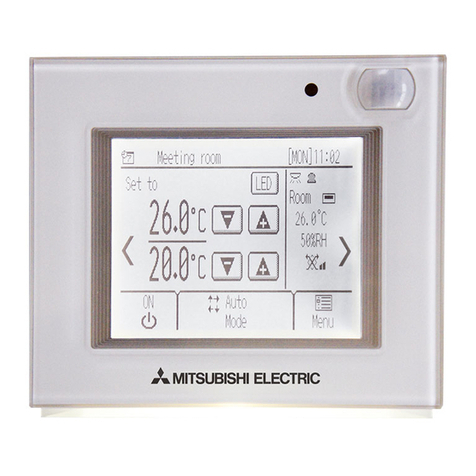
Mitsubishi Electric
Mitsubishi Electric par-u02meda Operation manual
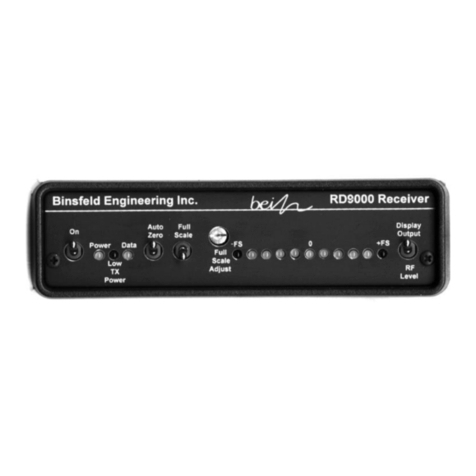
Binsfeld
Binsfeld TorqueTrak 9000 user manual
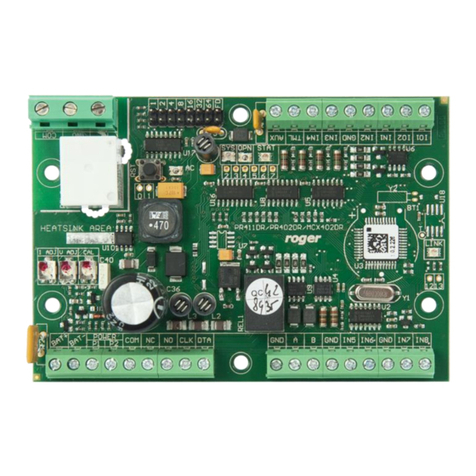
Roger
Roger MCX402-BRD installation manual

Siemens
Siemens REV32 installation instructions
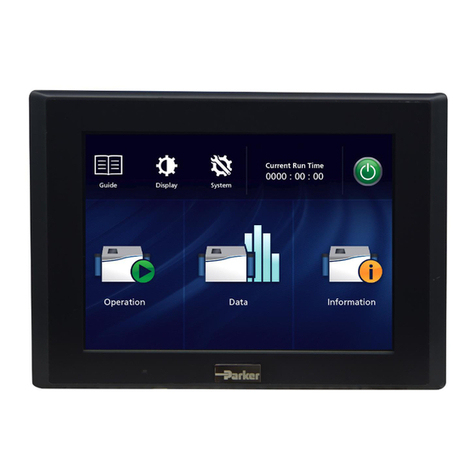
Parker
Parker Sea Recovery Aquamatic Quick start & troubleshooting guide

Siemens
Siemens SINUMERIK 840D Operator's guide
